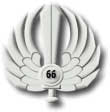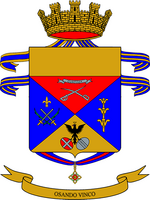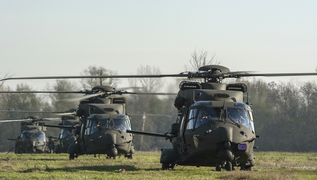Brigata aeromobile “Friuli”
The Brigata aeromobile “Friuli” ( German Air Movable Brigade Friuli ) is an association of the Italian Army , which consists of army aviation forces , ground troops and an air mobile infantry battalion . The brigade's headquarters are in Bologna , the subordinate units are stationed in Emilia-Romagna and Friuli .
assignment
The airmobile brigade Friuli is subordinate to the divisional command "Vittorio Veneto" in Florence . It provides airmobile combat and support forces for stabilization missions, evacuation operations and temporary high-intensity combat missions within the framework of the EU , NATO , the UN or for national defense. If necessary, the brigade also takes backup and security tasks on behalf of civilian agencies .
structure
-
 Staff and Supply Association Friuli ( Bologna )
Staff and Supply Association Friuli ( Bologna ) -
 66th Trieste Airmobile Infantry Regiment ( Forlì )
66th Trieste Airmobile Infantry Regiment ( Forlì ) -
 5th Rigel Army Aviation Regiment ( Casarsa della Delizia near Pordenone )
5th Rigel Army Aviation Regiment ( Casarsa della Delizia near Pordenone ) -
 7th Vega Army Aviation Regiment ( Rimini -Miramare)
7th Vega Army Aviation Regiment ( Rimini -Miramare)
All regiments of the brigade have battalion strength .
equipment
The two army aviation regiments have Agusta A129 combat helicopters and transport helicopters u. a. of the pattern NH90 . If required, heavy transport helicopters of the type CH-47 Chinook from the 1st Army Aviation Regiment in Viterbo can be requested. The airmobile regiment is equipped , among other things, with the multi-purpose vehicle VTLM Lince .
history
1884 to 1940
On November 1, 1884, the Friuli Brigade with its two infantry regiments 87 and 88 was set up in Milan . From the following year, individual units were sent to East Africa, and from 1911 to Libya . During the First World War , the brigade fought together with the Cremona brigade in the 16th division near Monfalcone in 1915, near Asiago in 1916 and near Flitsch in 1917 , where a poison gas attack on October 24 resulted in heavy losses. The brigade remained in reserve until June 1918, then in Vallagarina until October 1918 . In 1919 the brigade was in the Canal Valley , then moved to its peace locations in Tuscany .
With the army reform of 1926, the brigades were abolished in their previous form. The 87th Infantry Regiment was initially disbanded in Siena on this occasion , but was re-established in 1937 and temporarily took on training tasks. The 88th formed, together with the 21st and 22nd Infantry Regiments of the former Cremona Brigade and the 7th Artillery Regiment, the 28th Division in Livorno , which was renamed the 20th Infantry Division in 1934. In the course of another army reform in 1939, the so-called binary or two-tier (infantry) divisions were introduced, which usually took over the names and sister regiments of the old brigades. As a result, the 20th Friuli Infantry Division was established in Livorno in 1939 with the two infantry regiments 87 and 88. The 35th artillery regiment and other division troops were added . The 44th Cremona Infantry Division was set up with the two regiments mentioned, 21 and 22 .
1940 to 1945
In 1940 the Friuli Division was held in reserve in northern Italy. In April 1941 she took part in the Yugoslavia campaign led by the German Wehrmacht from Julisch Venetien . The division then returned to Italy, where it was prepared for the planned invasion of Malta . In November 1942, together with the Cremona division, they occupied the Mediterranean island of Corsica , where they remained as occupying forces for almost a year.
Immediately after the Cassibile armistice was announced to the public on September 8, 1943, battles broke out between Italian and German units in Corsica, particularly around the strategically important port city of Bastia . The 90th Panzer Grenadier Division withdrawn from Sardinia , the SS assault brigade “Reichsführer SS” and Italian paratroopers who wanted to continue the war on the German side initially brought Bastia under control on September 13 after heavy fighting. From September 29 to October 4, 1943, the German units withdrawing to the Italian mainland fought heavy fighting with the Friuli and the free French-Moroccan 4th Mountain Division, which had meanwhile arrived. The two Italian divisions Friuli and Cremona were then transferred to Sardinia, where they remained under Allied control and were partially dissolved. In the Friuli area , in November 1943, a Black Shirt Association, which had functioned as the division's third infantry regiment, was renamed the 387th Infantry Regiment, but this was dissolved completely at the end of August 1944. At that time the Friuli division had a little over 3,000 soldiers, no heavy weapons and an extremely poor supply situation.
In 1944 the Allies approved the formation of several Italian combat groups with strong divisions, which were to take part in the Italian campaign , especially in the battles for the position of the Goths . From the combat groups Legnano , Mantova , Folgore , Cremona and Friuli , the latter three were formed with the remnants of divisions lying in Sardinia.
From July 1944, the remnants of the Friuli division were relocated to a British training camp on the southern Italian mainland in San Giorgio del Sannio . The soldiers were partially malnourished and often no longer had their uniforms completely. After a refreshment of personnel and new equipment, the combat group was officially set up on September 19, 1944. In San Giorgio del Sannio two months of hard training by the British army followed , after which the combat group with its 35th artillery regiment and its two infantry regiments 87 and 88 (whose third battalions were provided by Granatieri di Sardegna ) to Tuscany, where the formation of the formation between Arezzo and Siena was completed. At the beginning of February 1945, the Friuli combat group replaced the Polish Kressowa division and its Italian partisan brigade Maiella in the Brisighella area. On the other side of the strategically important section of the front were parts of the 90th Panzer Grenadier Division and the 4th Paratrooper Division , against which a guerrilla war of increasing intensity was waged until the end of March 1945 and the southern Senio bank was finally brought under control. At Riolo Terme at the beginning of April the combat group managed to overcome the Senio, hold the bridgehead there and finally break through. Chase battles then broke out at Santerno , Castel San Pietro Terme , Casalecchio dei Conti and Varignana. The Idice bridgehead created by the 87th Regiment formed the prerequisite for the capture of Bologna , in which the Allies let parts of the Friuli combat group go ahead.
1945 to 1990
While maintaining the previous composition, the combat group was renamed the Friuli Infantry Division in October 1945 . She was stationed in Bolzano and South Tyrol until 1949 , after which she came to Florence , where she also received the 78th Lupi di Toscana infantry regiment, as well as another artillery regiment and an anti-aircraft regiment. In 1956 she formed the VI with the Trieste Infantry Division stationed in Bologna . Corps in Bologna, which a few years later was converted into a territorial command based in Florence. The two divisions of said VI. Corps were reduced to brigades between 1958 and 1960, with the traditional Friuli units being dissolved. From 1960, the Friuli Infantry Brigade consisted of the 78th Lupi di Toscana Infantry Regiment , the 19th Tank Battalion, the Friuli Artillery Battalion and an anti-aircraft battalion of the same name, as well as smaller support units. During the Cold War, the brigade mainly took on territorial security tasks in central Italy.
In the course of the army reform of 1975, the brigades divided into battalions became the standard. After the reorganization, the Friuli Motorized Brigade consisted of the 19th Tumiati Tank Battalion in Florence, the 78 Lupi di Toscana motorized infantry battalions in Scandicci , 87 Senio in Pistoia , 225 Arezzo in Arezzo , the 35th Artillery Battalion Riolo in Pistoia, and the Logistics Battalion Friuli in Florence and from smaller support units as well as from the non-active 35th (reserve) infantry battalion Pistoia at the place of the same name. From 1986 the brigade formed the "Rapid Reaction Force" ( Forza d'Intervento Rapido , HQ Florence, 1997 dissolved) of the Italian armed forces with the Folgore paratrooper brigade, which was also stationed in Tuscany, and other smaller units ( San Marco Regiment ) . In the late 1980s, the brigade was in a sense "airmobile". Air transport forces of the Italian Air Force often brought units of the brigade for maneuvers and exercises to southern Italy, which had received greater attention due to tensions with Libya .
1990 to 2013
After the Cold War, the Friuli merged with the mechanized infantry brigade Trieste in Bologna as part of the disbanding wave of 1991 . The Trieste had distinguished itself as a motorized infantry division from 1941 to 1943 in North Africa. According to a "traditional decree" of the Ministry of Defense, associations that had distinguished themselves during the war from 1940 to 1943 were allowed to continue to exist after 1945, provided they were subordinate to large associations that had participated in the war of liberation from 1943 to 1945. For this reason the Friuli "took over" the Trieste brigade in 1991 and moved its headquarters to Bologna. In the years that followed, the subordinate battalions, which for reasons of tradition took on the name regiment again, changed several times. However, with the 66th Trieste Infantry Regiment , the traditions of the former Trieste Division and Brigade were preserved within the Friuli Mechanized Brigade .
In 2001, the Army General Staff ordered the Friuli to be converted from a mechanized to an airmobile brigade. After the restructuring, the brigade with staff in Bologna consisted of the 66th Trieste Airmobile Regiment in Forlì , the 5th Rigel Army Aviation Regiment in Casarsa della Delizia , the 7th Vega Army Aviation Regiment in Rimini and the Savoia Cavalleria Cavalry regiment in Grosseto as ground-based components . Politically motivated proposals to merge Friuli with the Folgore paratrooper brigade based on the example of the British 16 Air Assault Brigade were not taken into account.
After the end of the Cold War, the Friuli Brigade took part in a number of missions and exercises at home and abroad. 1992 and 1993 parts of the brigade were used in Sicily to maintain public safety. After that, until the beginning of 1994, two mechanized infantry units of the brigade were sent to Somalia on a foreign mission ( UNITAF ) . In 1997 a military mission followed in Albania ("Operation Alba"), in 1998 participation in the SFOR mission in Bosnia and Herzegovina (" Operation Joint Forge ") and from October 1999 to April 2000 another mission in Albania to support KFOR ( Communication Zone West ). After the brigade was restructured and a number of exercises (including in Poland and Tunisia ), the airmobile brigade was deployed several times in Iraq , Afghanistan and Lebanon from 2004 onwards .
As part of a reorganization of the Italian army, a new Friuli Divisional Command was set up in Florence in July 2013 , which temporarily shared names, history and traditions with the Friuli Airmobile Brigade and at the same time succeeded the former Friuli Infantry Division . This divisional command was given the name Vittorio Veneto on July 1, 2019 , which means that the names and traditions of the major associations with the name Friuli are again exclusively with the brigade.
photos
See also
- List of Italian regiments
- List of major Italian associations
- 16th Air Assault Brigade
- 11 Luchtmobiele Brigade








